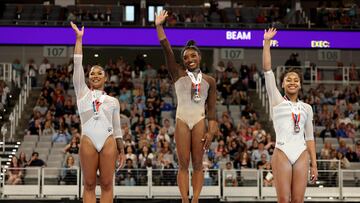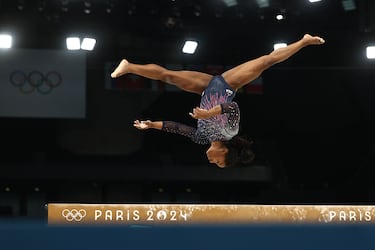USA gymnastics at the 2024 Olympics in Paris: disciplines, participants, format and scoring
The artistic gymnastics competitions at the Paris 2024 Olympic Games will begin this Saturday, July 27.

Artistic gymnastics is one of those sports that has endured through the years. In modern times, it was first introduced during the Athens 1896 Olympic Games, and since then, it has been part of each of the Games’ editions.
For the Paris 2024 Olympic Games, officially starting this Friday, July 26, 192 gymnasts—96 men and 96 women—will search for glory. Unlike the Tokyo 2020 Olympic Games, teams in both the women’s and men’s events in this 2024 edition will be comprised of five gymnasts, instead of four.
The artistic gymnastics competition will start this Saturday, July 27, at 5 a.m. ET, with the Men’s Qualifiers, and for the next nine days, sport enthusiasts around the world will enjoy seeing the best of the best compete.
However, for newcomers to the sport, it could be a bit difficult to understand the artistic gymnastics format, but don’t worry, we’ve got you covered. Let’s have a look at how this discipline works and who is representing Team USA.
Who is participating in artistic gymnastics from Team USA?
For the Paris 2024 Olympic games, more than 500 athletes are representing Team USA, and from this exclusive number, 13 will compete in artistic gymnastics, two in trampoline, and one in rhythmic gymnastics:
- Artistic gymnastics: Simon Biles, Jade Carey, Jordan Chiles, Suni Lee, Hezly Rivera, Asher Hong, Paul Juda, Brody Malone, Stephen Nedoroscik, and Frederick Richard.
- Trampoline: Jessica Stevens and Alexi Shostak.
- Rhythmic gymnastics: Evita Griskenas.
team photo ♥️ pic.twitter.com/ljwG1SVMEk
— USA Gymnastics (@USAGym) July 25, 2024
What are the gymnastics events at the Paris 2024 Olympic Games?
Let’s get into the real deal. Gymnasts will rotate between different events, which are:
- Men’s: Floor exercise, pommel horse, rings, vault, parallel bars, high bar.
- Women’s: Vault, uneven bars, balance beam, and floor.
Both branches will follow the Olympic Order. For instance, if a team starts on the pommel horse, they will do rings afterward; the team will continue performing in that order until they arrive at their last event, the floor exercise. This applies to both men’s and women’s teams.
What is the format of gymnastics in the Paris 2024 Olympic Games?
Gymnastics competition at the Paris 2024 Olympic Games will be divided into four different phases:
- Qualification (no medals awarded)
- Team finals (medals awarded)
- All-around Finals (medals awarded)
- Event finals (medals awarded)
Every gymnast must participate in the qualifiers, even if they compete individually. The qualifiers will feature 12 teams, both in men’s and women’s events, divided into three subdivisions for the men and five for the women.
During their time slot, teams will rotate between the events until they complete the circuit, and the order of gymnasts performing in each apparatus will be determined by the coaches.
This round will determine the qualified gymnasts for the final all-around, team, and event. Gymnasts will perform one routine per event, except for the vault, which requires two attempts if intentions are to qualify for the vault event final. If an athlete wants to participate in the all-around finals, they must perform in all four events (for women) or six events (for men).
Each team can select four athletes to compete in each event, and only the best three scores will be taken into account for the team’s global score (four-up, three-count format). In the qualifiers, a team’s final score is determined by 18 scores (best three in each event) for men and 12 (best three in each event) for women.
Eight teams will qualify for the team finals. The top 24 individual scores qualify for the all-around final, while the best eight gymnasts per apparatus will qualify for the event final. It is crucial to mention that scores will not carry over to the finals; once qualified for the next round, teams/athletes will start again from zero, and only two athletes per country can qualify.
How will the gymnastics finals format work at the Paris 2024 Olympic Games?
Exactly like the qualifiers, the team scores in the finals will be 12 routine scores for women and 18 for men. However, this time, only three athletes (not four) will be able to perform on a given apparatus. Each team will rotate between events, but this time, the starting order is determined by the team’s positions in the qualifiers.
The first and second-ranked teams will start on the floor (men) and vault (women); the third and fourth will begin at the pommel horse (men) and uneven bars (women); the fifth and sixth will start in the rings (men) and balance beam (women); and the seventh and eighth will perform first at the vault (men) and floor (women). The team with the highest cumulative score wins the gold medal!
In the all-around final, women and men will be divided into four groups of six, and the scores from each event will be added. The gymnast with the highest total score in men’s and women’s branches will win.
Finally, the event finals (apparatus finals) include the eight best gymnasts per apparatus. Each athlete will make one appearance in the event they qualify for, except for the vault, where they will perform two times, and the result will be determined based on the average score of the two vaults.

How does scoring work in gymnastics in the Paris 2024 Olympic Games?
During all the rounds, gymnastics are scored based on two factors:
- Execution score (E)
- Difficulty score (D)
Related stories

Gymnastics at Paris 2024: what to know

Flag bearer Gauff set for Olympics debut
The E-score begins at 10.0 for each participant, and the judges decide to rest marks based on the gymnast’s performance. Marks deductions may vary depending on slight flaws, which could mean a slight point reduction to a fall that could result in the performer losing an entire point.
The D-score is determined by the difficulty of the gymnast’s routine, which the Code of Points values. It doesn’t have a maximum value, although it averages between 5 and 7, and the athlete could not earn the full value depending on the flaws realized during the performance.
Complete your personal details to comment